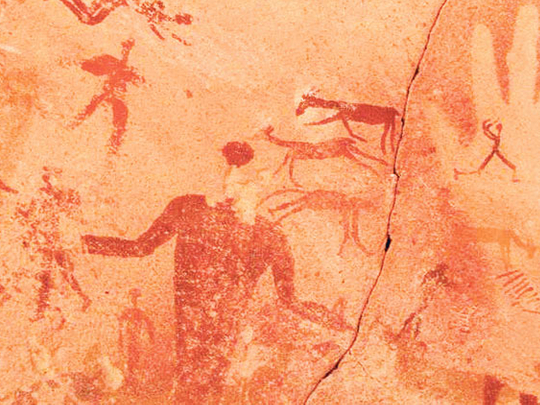
Cairo: Archaeologists are studying prehistoric rock drawings discovered in a remote cave in 2002, including dancing figures and strange headless beasts, as they seek new clues about the rise of Egyptian civilisation.
Amateur explorers stumbled across the cave, which includes 5,000 images painted or engraved into stone, in the vast, empty desert near Egypt's southwest border with Libya and Sudan.
Rudolph Kuper, a German archaeologist, said the detail depicted in the "Cave of the Beasts" indicate the site is at least 8,000 years old, likely the work of hunter-gatherers whose descendants may have been among the early settlers of the then-swampy and inhospitable Nile Valley.
The cave is 10 kilometres from the "Cave of the Swimmers" romanticised in the film the English Patient, but with far more, and better preserved, images.
By studying the sandstone cave and other nearby sites, the archaeologists are trying to build a time line to compare the culture and technologies of the peoples who inhabited the area.
"It is the most amazing cave ... in North Africa and Egypt," Karin Kindermann, member of a German-led team that recently made a trip to the site 900 kilometres southwest of Cairo, said.
"You take a piece of the puzzle and see where it could fit. This is an important piece," she said.
The Eastern Sahara, a region the size of Western Europe that extends from Egypt into Libya, Sudan and Chad, is the world's largest warm, dry desert. Rainfall in the desert's centre averages less than two millimetres a year.
The region was once much less arid.
Settlements
About 8500 BC, seasonal rainfall appeared in the region, creating a savanna and attracting hunter-gatherers. By 5300 BC, the rains had stopped and human settlements receded to highland areas. By 3500 BC, the settlements disappeared entirely.
"After 3-4,000 years of savanna life environment in the Sahara, the desert returned and people were forced to move eastwards to the Nile Valley, contributing to the foundation of Egyptian civilisation, and southwards to the African continent," Kuper, an expert at Germany's Heinrich Barth Institute, said.
The mass exodus corresponds with the rise of sedentary life along the Nile that later blossomed into pharaonic civilisation that dominated the region for thousands of years and whose art, architecture and government helped shape Western culture.
"It was a movement, I think, step-by-step, because the desert didn't rush in. The rains would withdraw, then return, and so on. But step by step it became more dry, and people moved toward the Nile Valley or toward the south," Kuper said.












